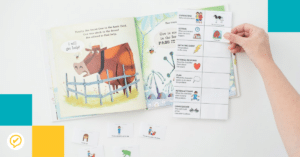This is a guest blog post from Rebecca, another SLP, all about complex syntax intervention with younger students!
How I Approached Syntax Intervention with Younger Students
While working with younger children with language impairment, I typically utilize my previous grad school instruction and SLP supervisor training. I tend to approach my therapy sessions by using simple sentence structures that target morphosyntactic (grammar and sentence structure) forms and increasing utterance length. Targeting complex syntax with younger students wasn’t at the top of my radar!
So, after collecting a thorough language sample from my student and analyzing it for morphological and syntactic errors, I would determine what skills to target first. Traditionally, I would target morphosyntactic forms including markers of tense and/or agreement, such as past tense –ed, third person singular –s, auxiliary be, and copula be) in a simple sentence frame (e.g., The girl pets the puppy).
My therapy goal may look something like this: By June 2022, when participating in story retell, Johnny will independently use regular and irregular past tense verb forms, improving from 50% to 80% accuracy, as measured by SLP data.
Sound familiar?
Additionally, I would target increased sentence length by teaching students to add more descriptive words (adjectives and adverbs) to their utterances. But how can I target expanding sentence length beyond the simple sentence framework? Don’t my students need to master their morphosyntactic forms in simple sentences before I can move on?
If, like me, you thought you needed to wait until students entered the 3rd-grade to incorporate complex syntax forms in your therapy intervention, think again!
Typical Language Development and Complex Syntax with Younger Students
In typical language development, children begin to use complex sentence forms soon after they combine words into sentences, usually by age 2-3 years (Arndt & Schuele, 2013; Bloom, Tackeff & Lahey, 1984; Limber, 1973).
Reduced infinitives (e.g., I wanna sleep) and simple infinitives (e.g., Everyone wants to go) are two of the earliest forms of complex syntax produced by young children with a Mean Length of Utterance (MLU) below 3.0.
Beyond an MLU of 3.0, children start to produce a wide range of complex syntax forms. For a comprehensive view of complex syntax forms see Schuele & Dykes, 2005.
Why Target Complex Syntax in Therapy with Younger Students?
So why is this important to remember? For many of the students with language impairments on our caseloads, their development in use and mastery of complex syntax forms is often delayed by as many as two years behind their age-matched peers (Eisenber, 2003; Fletcher, 1992; Marinellie, 2004; Schuele & Dykes, 2005).
Moreover, complex syntax is needed to meet the academic demands of the classroom curriculum and common core standards.
Reviewing the Evidence for Complex Syntax
You might be asking yourself at this point, “Okay, I’m willing to give complex syntax a try with my younger students, but how?”
We will begin by reviewing a series of three studies by Nelson, Camarata, and colleagues (Camarata & Nelson, 1992; Camarata, Nelson, & Camarata, 1994; Nelson, Camarata, Welsh, Butkovsky, & Camarata, 1996), that compared two approaches to complex syntax, direct imitation and conversational recast.
But first, disclaimer alert! There is limited research available targeting complex syntax interventions for young children with language impairment, so as in all situations of determining the best approach for your students, it is important to consider the three pillars of Evidence-Based Practice–scientific evidence, clinical expertise, and client perspectives.
Okay, let’s dive in! A within-subject design was used to monitor progress of individual targets including morphosyntax, simple syntax, and/or complex syntax. Children aged 4-7 years participated in 1:1 direct intervention for 30-60 minutes per week for a range of 3-5 months of treatment.
Researchers found that young children with and without language impairments learned their syntax targets in a spontaneous context much faster during the conversational recast condition (fewer sessions and fewer therapist recasts).
Conversely, when engaging in the direct imitation condition for elicited productions of the syntax targets, young children initially learned faster, but did not carry over the skill to spontaneous contexts as quickly.
All signs point to the conversational recast approach when learning and retaining new syntactic structures. Okay, but how can I start using this approach in therapy?
Recasting in Speech Therapy
Let’s define it first! Sentence recasts are the immediate therapist response to a child’s utterance that repeats some of the child’s words and corrects or modifies the morphological or syntactic form of the utterance.
Key Points When Targeting Complex Syntax with Younger Students
– Recasts are a way to add or correct information without disrupting the flow of the conversation.
– Recasting is another form of modeling.
– Recasts occur when the therapist repeats the correct or modified syntactic structure.
Example
The therapist shows the child a picture of a puppy with a ball.
– Child: “The ball is red.”
– Therapist: “Who is playing with the ball?”
– Child: “The puppy.”
– Therapist: “The ball that the puppy plays with is red.”
Added Benefits
– Therapy can be addressed in a structured or naturalistic setting
– The therapist can engage in the child’s interest and language level
– The child does not receive negative or corrective criticism
– The child does not have to repeat anything
– Parents, teachers, and peers can be trained to support this intervention
I hope you’ve enjoyed this overview on using conversational recasts to improve complex syntax for younger children!
Don’t forget to check out the blog next time when we discuss another approach to addressing complex syntax, repeated storybook reading within a scaffolded-language structure (RSR-SLS; Bellon-Harn, Byers, & Lappi, 2014).
References
Arndt, K. B., & Schuele, C. M. (2013). Multiclausal utterances aren’t just for big kids: A framework for analysis of complex syntax production in spoken language of preschool- and early school-age children. Topics in Language Disorders, 33(2), 125–139.
Bellon-Harn, M. L., Byers, B. A., & Lappi, J. (2014). Treatment intensity: Effects of interactive book reading on narrative abilities in preschool children with SLI. Communication Disorders Quarterly, 35(4), 226–236.
Bloom, L., Tackeff, J., & Lahey, M. (1984). Learning to in complement constructions. Journal of Child Language, 11(2), 391–406.
Camarata, S. M., & Nelson, K. E. (1992). Treatment efficiency as a function of target selection in the remediation of child language disorders. Clinical Linguistics & Phonetics, 6(3), 167–178.
Camarata, S. M., Nelson, K. E., & Camarata, M. N. (1994). Comparison of conversational-recasting and imitative procedures for training grammatical structures in children with specific language impairment. Journal of Speech, Language, and Hearing Research, 37(6), 1414–1423.
Eisenberg, S. (2003). Production of infinitival object complements in the conversational speech of 5-year-old children with language impairment. First Language, 23(3), 327–341.
Fletcher, P. (1992). Subgroups in school-age language impaired children. In P. Fletcher & D. Hall (Eds.), Specific speech & language disorders in children (pp. 152–165). London, England: Whurr.
Limber, J. (1973). The genesis of complex sentences. In T. E. Moore (Ed.), Cognitive development and acquisition of language (pp. 169–185). New York, NY: Academic Press.
Marinellie, S. A. (2004). Complex syntax used by school-age children with specific language impairment (SLI) in child–adult conversation. Journal of Communication Disorders, 37(6), 517–533.
Nelson, K. E., Camarata, S. M., Welsh, J., Butkovsky, L., & Camarata, M. (1996). Effects of imitative and conversational recasting treatment on the acquisition of grammar in children with specific language impairment and younger language-normal children. Journal of Speech, Language, and Hearing Research, 39(4), 850– 859.
Stoeckel, R. [MedBridge]. (2020, July 7). Demonstration of Recasting [Video]. https://youtu.be/WqT0Lzb_yts
Schuele, C. M., & Dykes, J. C. (2005). Complex syntax acquisition: A longitudinal case study of a child with specific language impairment. Clinical Linguistics & Phonetics, 19(4), 295–318.
Schuele, C. M., & Wisman Weil, L. (2004). Complex syntax productions of children with specific language impairment and MLU-matched peers. Poster session presented at the Symposium on Research in Child Language Disorders, Madison, WI.






Leave a Reply